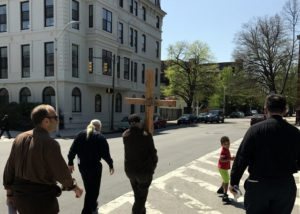By Rev. Grey Maggiano
Plans for Unveiling
Daughters of the Confederacy Announces Program
April 24th, 1903
Mrs. D. Giraud Wright (1632 Park Ave.), President of the Maryland Daughters, announced
at social meeting of the Baltimore Chapter …The Strains of Dixie will mark the formal
opening of the program, and following this the invocation by the Rev. William M.
Dame (Rector, Memorial Episcopal Church), Chaplain of the Maryland Daughters
of the Confederacy.”

Almost 114 years ago to the day, most of Bolton Hill—some 700 people stood on the stage alone!— turned out for the dedication of the Daughters of the Confederacy Monument on Mt. Royal Avenue. Leading the proceedings were the then-Rector of Memorial Episcopal Church and the President of the Daughters of the Confederacy, a longtime Park Ave. resident.
This monument was one of the fourteen stops on Memorial Church’s Repenting for Racism: Stations of the Cross Walk last month, which was held on Good Friday.
After a long period of research and truth-telling, Memorial Members selected fourteen sites around the neighborhood that call attention to both our parish’s and our neighborhood’s legacy of racism. These included:
- The former site of the segregated Bolton Hill Recreation Center on the east side of the 1300 block of Bolton Street;
- 1212 Bolton Street, which was purchased by a black Baptist pastor who was forcibly evicted by unhappy neighbors; and
- Memorial Church’s own parish hall, in which blackface minstrel shows were staged to entertain the neighborhood for many years.

When people ask me why we need to do these kinds of things— why we need to “drudge up” this ugly history, and remind ourselves of the painful past— I point to stories like this. Or I tell of the strong neighborhood activism supporting segregated housing, or my ancestor’s letter to the editor urging the restriction of the right to vote for “the Negroe.”
We need to do these kinds of things because they are not ancient history. They didn’t just happen before the Civil War, or in the 1800s, but in the mid-twentieth century. Current parishioners and neighbors were alive when many of these events took place. And, though most Bolton Hill residents didn’t live here then, there are many, many neighbors, churches and institutions across Eutaw Place who do remember.
The reality is that we have asymmetrical access to information and asymmetrical notions of history. While Bolton Hillers celebrate the very diverse, very inclusive neighborhood we see between Mt. Royal and Eutaw, and Dolphin and North Ave., neighbors on the other sides of these boundaries remember a not-too-distant past when to walk through Bolton Hill as a person of color guaranteed a visit from the police.
Perhaps you, like me, have asked why Bolton Hill retains its reputation as a predominantly white, wealthy neighborhood when the actual numbers suggest it is much more economically and racially diverse? Or why your institution or organization, like our church, has trouble developing relationships with organizations west of Eutaw Place? Or perhaps you have wondered why urban renewal, redlining, and segregation didn’t have the same effect in Bolton Hill as it did in Reservoir Hill, Upton, or Penn North?
Memorial Church’s research shows that the answer to all of these questions lies in our own history.
They say that those who don’t know their history are doomed to repeat it. Whether or not that is true in this case, our lack of knowledge of the past makes it very hard to dialogue with those who continue to feel its impact.
We hope that by bringing these truths to light, we can help all of our neighbors, black and white, rich and poor, longtime residents and new arrivals, to understand both the problematic history of these few city blocks, and to band together to set out a different future— for our Church, for our neighborhood, and perhaps for our whole city.
For more information please visit Memorial Episcopal online, and see this related article about the Repenting Racism walk in the Washington Post.
